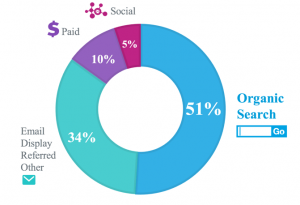A whole lot goes on online. There’s a lot of content generated between social media, google searches, and so much more. Content marketers work to understand where a particular brand or company is talked about, what exactly is being talked about, and who is outranking the brand in terms of reputation. When it comes to digital marketing, a company’s share of voice (sometimes known as the SOV) describes the share of conversations that surround a brand, products and services, and various marketing channels like blogs and social media. This means that brand awareness can be measured via different marketing channels compared to the company’s competitors. When you’re measuring your share of voice, you are determining how effective your brand is in their marketing efforts compared to marketing efforts put forth by competitors. The higher your brand’s share of voice is, the more popular and significant your brand is in the industry.
 Share of voice can be measured for different channels such as social media and SEO and although the steps involved change slightly, the overall equation is fairly simple: Brand advertising / Total market advertising = Share of voice. It is crucial to be mindful of the amount of mentions made about your brand during a certain amount of time. Next it’s time to follow this process for your competitors, keeping track of all related keywords. By calculating the total amount of mentions and dividing it by 100, you can calculate what 1 percent of the total voice for your group is. You can then separate your brand’s total amount of mentions and divide it by whatever number was first calculated. This can be done repeatedly to calculate the total voice for each competitor.
Share of voice can be measured for different channels such as social media and SEO and although the steps involved change slightly, the overall equation is fairly simple: Brand advertising / Total market advertising = Share of voice. It is crucial to be mindful of the amount of mentions made about your brand during a certain amount of time. Next it’s time to follow this process for your competitors, keeping track of all related keywords. By calculating the total amount of mentions and dividing it by 100, you can calculate what 1 percent of the total voice for your group is. You can then separate your brand’s total amount of mentions and divide it by whatever number was first calculated. This can be done repeatedly to calculate the total voice for each competitor.
In order for marketers to garner consumer interest and get them to buy products, a brand needs to be visible, meaning that brand awareness is priority for marketers. The share of voice metric is not only extremely useful in understanding how visible a brand is, but in measuring marketing efforts across different channels as well.
 According to an article on share of voice by Talk Walker, there are three main segments that should be considered when growing a brand’s share of voice. The first segment is traditional media, meaning achieving brand mentions through public relations and sponsorship strategy. The second segment is utilizing influencers and industry experts. When a brand is mentioned by a particularly strong influencer, brand awareness can skyrocket. The third segment is user-generated content. By making customers happy, they will then turn around and create satisfaction-driven content, which will reach the ears of other customers and improve brand awareness.
According to an article on share of voice by Talk Walker, there are three main segments that should be considered when growing a brand’s share of voice. The first segment is traditional media, meaning achieving brand mentions through public relations and sponsorship strategy. The second segment is utilizing influencers and industry experts. When a brand is mentioned by a particularly strong influencer, brand awareness can skyrocket. The third segment is user-generated content. By making customers happy, they will then turn around and create satisfaction-driven content, which will reach the ears of other customers and improve brand awareness.
Share of voice is a very helpful tool in understanding how your business compares to competitors within the same industry. Tracking your brand’s SOV over a period of time can help you understand how relevant you currently are in the market. It is also a great tool in determining in what area your brand must gain more strength. For example, if you have a very strong share of voice when it comes to SEO, but a weak share of voice in the social media market, this serves as an indicator as to where a company must improve. It’s important to know what consumers are saying about your brand, and just as important to know what they are saying about your competitors. Calculating share of voice provides important information that can help your brand be viewed in a more positive light.